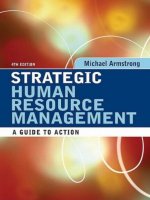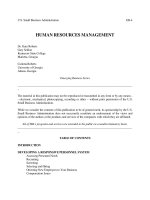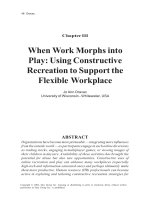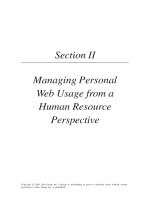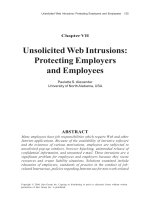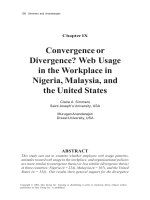Human Resources Management Slide - 8 chapters
Bạn đang xem bản rút gọn của tài liệu. Xem và tải ngay bản đầy đủ của tài liệu tại đây (192.71 KB, 23 trang )
chapter
1
Human Resource Management
Human Resource Management (HRM)
The overview
HRM?
Activities?
Descriptions/approaches
Foundations of HRM
Strategic HRM
HRM professionals/specialist
HRM management and strategy...
•
•
•
•
•
•
•
Human Resource Management (HRM)
• The function performed in organizations that facilitates the most effective use of people
(employees) to achieve organizational and individual goals.
HRM Activities
• Equal employment opportunity (EEO) compliance
• Job analysis
• Human resource planning
• Employee recruitment, selection, motivation, and orientation
• Performance evaluation and compensation
• Training and development
• Labor relations
• Safety, health, and wellness...
Four descriptions of the HRM function
1.
2.
3.
4.
It is action-oriented
It is people-oriented
It is globally-oriented
It is future-oriented
Historical Foundations of HRM
Scientific Management
Welfare Work
Industrial Psychology
Human Relations
Strategic Importance of HRM
• The increased strategic importance of HRM means that:
Human resource specialists must show that they contribute to the goals and mission of the firm
• The actions, language, and performance of the HRM function must be:
Measured
Precisely communicated
Evaluated...
The new strategic positioning of HRM
means that accountability must be taken
seriously
Key Strategic HRM Concepts That Must Be Applied
• Analyzing and solving problems from a profit-oriented point of view
• Assessing and interpreting costs or benefits of HRM issues
• Using planning models that include realistic, challenging, specific, and meaningful goals
• ...
Key Strategic HRM Concepts That Must Be Applied
• ....
• Preparing reports on HRM solutions to problems encountered by the firm
• Training the human resources staff
Emphasizing the strategic importance of HRM
Emphasizing the importance of contributing to the firm’s profits
If the HRM function is to be successful,
managers in other functions must be
knowledgeable and involved
HRM and Organizational Effectiveness
• Performance
• Legal compliance
• Employee satisfaction
• Training effectiveness
• Absenteeism
• Training return on investment
• Turnover
• Grievance rates
• Accident rates
Objectives of the HRM Function
• Helping the organization reach its goals
• Employing the skills and abilities of the workforce efficiently
• Providing the organization with well-trained and well-motivated employees
• Increasing to the fullest the employee’s job satisfaction and self-actualization
• Developing and maintaining a quality of work life that makes employment in the organization desirable
• ...
Objectives of the HRM Function
• ...
• Communicating HRM policies to all employees
• Helping to maintain ethical policies and socially responsible behavior
• Managing change to the mutual advantage of the organization’s stakeholders
• Managing increased urgency and faster cycle time
Performs HRM Activities
In most organizations two groups perform HRM activities:
1)
HR manager-specialists (staff)
2)
Operating managers (line)
Competencies Needed by HR Professionals
• Communication skills
• Problem solving
• Leadership
• Recruiting/staffing
• Employment law
• Training and development
• ...
Competencies Needed by HR Professionals
• ....
• Technology
• Forecasting
• Compensation design
• Benefits design and administration
• Accounting and finance
• Record keeping...
The HR department has a responsibility
to be a proactive, integral component of
management and the strategic planning
process
HRM’s Place in Management
HRM must:
• ascertain specific organizational needs for the use of its competence
• evaluate the use and satisfaction among other departments
• educate management and employees about the availability and use of HRM
services...
HRM Strategy
• The HRM strategy will help aggregate and allocate a firm’s resources into a unique entity
on the basis of:
Its internal strengths and weaknesses
Changes in the environment
The anticipated actions of competitors
Relationship Between Strategy, Objectives, Policies, and
Rules:
Strategy – The plan that integrates major objectives
More specific
Objectives – Goals that are specific and measurable
More specific
Policies – Guides to decision making
More specific
Procedures/Rules – Specific directions for decision
making
Summary
• HRM is action-oriented, individual-oriented, globally-oriented, and future oriented
It focuses on satisfying the needs of individuals at work
• HRM is a necessary function
Effectively performed, it can make the crucial difference between successful and unsuccessful organizations
• One of the challenges faced in HRM is that many decisions require input from both operating managers and HR
specialists
• This dual role can lead to conflict, or it can result in more effective HRM decisions
